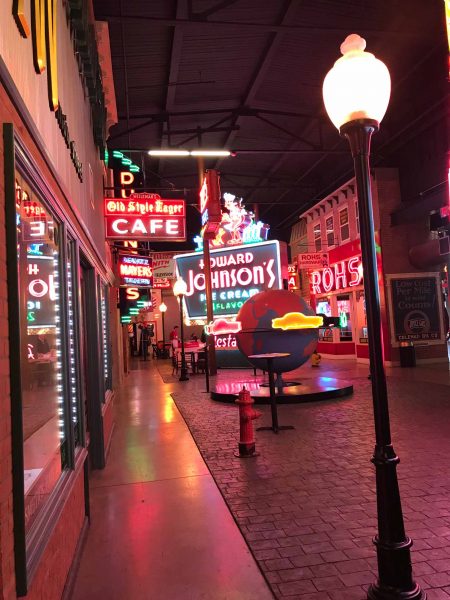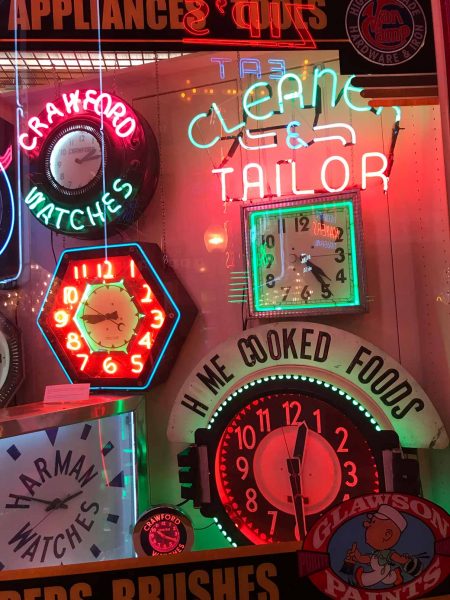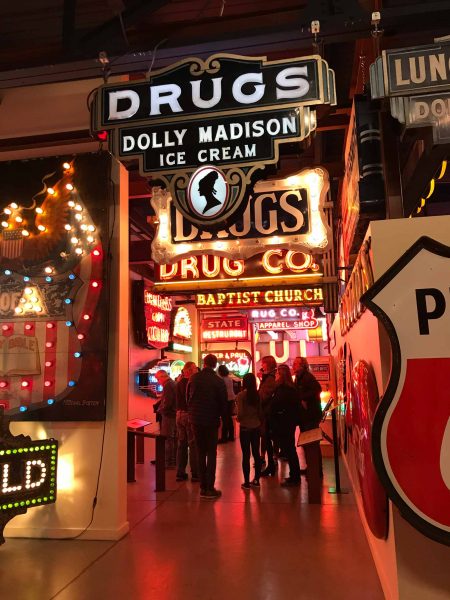The American Sign Museum is off the beaten path. Hidden away in Camp Washington is a national museum devoted solely to signs. Located on 1330 Monmouth Ave., the museum is a one-story 20,000 square-foot building which covers over a century of signs. From hand-painted signs with gold leaf, the earliest electric signs, art deco neon signs to the modern plastic-faced signs, the museum offers a wide variety of signage.
Why go here rather than a traditional art museum? Founder Tod Swormstedt says the museum is the only one of its kind in the nation. “We are a museum of many types of signs from all over the country. It is a microcosm of the history of signs. One gets a feel for the tools, artwork and even salesman samples,” he said. The museum has a catalog of signs as well as a collection of 300 books about signs.
Is this vernacular pop culture or fine art?
Swormstedt cites a fine line between commercial art and fine art. “The only difference is the zeros,” he said. He thinks commercial art requires tighter specifications, a budget and a deadline taking an idea and making it real, transposing a concept into reality. He also notes a trend in sign making.
“I’m a visual person, who appreciates a sign’s three dimensions and history,” Swormstedt said. He commented on the craftsmen working behind the scenes on signs. “I appreciate what they do, run a business, design and install. I respect people who do what I can’t. I am not very mechanical,” he added.
Swormstedt noticed that old signs have become collectibles reflecting a trend in mid-century art of the 30’s, 40’s and 50’s. He referred to an interest in retro signs that reflect the space age. He recalled the influence of sign design from the Sputnik era, when the Soviet Union launched the first artificial Earth satellite, in the 50’s and the former TV show, the Jetsons, a sitcom about a space-age family.
Artist Joseph Cornell (1903 – 1972) started the use of everyday objects in his art by placing them in shadow boxes creating miniature tableaux. Notes about his work refer to his visual imagery of popular culture. Signs reflect this theme as well.
In the book Magic Sign: The Electric Art/Architecture of Las Vegas, Charles F. Barnard described signs in Las Vegas as unique architecture. He referred to sign architects as set designers. Barnard talked about the introduction of the first neon signs in the 1930’s. Architect Robert Venturi described Las Vegas signs as defined with “younger than life graphics and sign imagery.”
In the 1960’s, inspired by Robert Rauschenberg’s example, a group of even younger artists, led by Andy Warhol, Claes Oldenburg and Roy Lichtenstein, invented a new American realism, Pop Art, according to Henry Sayre, author of A World of Art. “Pop represented life as America lived in a world of Campbell’s soup cans, Coca-Cola bottles and comic strips,” he wrote. “Lichtenstein’s giant painting Whaam! Indicates, by its very size, the powerful of popular culture in our emotional lives,” according to the writer. “One of the chief tactics of the Pop artists, in fact, was to transform the everyday into the monumental,” he said. “Artists turned to slick renderings made by mechanical reproduction techniques, that evoked commercial illustration more than fine art,” he said. Signs followed suit.
The concept of the museum was born in 1999 as the National Sign of the Times Museum and opened in the basement of ST Media Group, Swormstedt’s family business, on Eighth and Broadway. In May 2005, it became the American Sign Museum, located in Essex Studios in Walnut Hills where Swormstedt began to grow his business. The 4,500-feet museum was the anchor tenant of Essex, open on Saturdays or by appointment.
Swormstedt eventually moved the museum to Camp Washington in 2010 after looking at Over-the-Rhine and Walnut Hills among other locations. He wanted an industrial area, which Camp Washington is, near the now closed Sara Lee Corporation, formerly Kahn’s, on Spring Grove Ave. High ceilings, ample parking and open architecture were on his wish list. He found them on Monmouth St. Since he had years of experience writing about signs, he had contacts in the industry. They would call with potential signs for the museum. He also attended antique sign shows such as the one in St. Charles, Illinois looking for prospective pieces to purchase.
“I had leverage,” Swormstedt said. He officially opened the American Sign Museum in 2012 after extensive remodeling of the building. A bridge connecting Monmouth to Central Parkway also brought in more visitors.
The museum not only includes vintage signs, but also Save Our Signs, a resource center for preservation; an education program; restoration service, tours, event space and an online archive. The museum shows the evolution of sign design with varied color schemes, material choices and trends. Swormstedt served for 26 years on the staff for Signs of the Times Magazine, which sparked his interest in signs.
The museum offers visitors a chance to see local iconic signs, such as Frisch’s Big Boy, Dusing Brothers Ice from Elsmere, Kentucky; Habig’s Restaurant on Harrison Ave. in Westwood, and the well-known Suder’s Art Store and national signs such as El Rancho Mexican Restaurant from Kansas City, McDonald’s in 1963 from Huntsville, Alabama, Howard Johnson from Utica, New York and Satellite Shopland from Anaheim, California.
But, the museum has longer legs. Cincinnati Gardens had letters erected for its 1949 opening. The Gardens, now demolished, has donated letters to the American Sign Museum. The museum will display them on the Monmouth side of the building in early 2018. The Carol Ann & Ralph V. Haile, Jr./US Bank Foundation has provided funds to install the letters.
ASM tracks signs to be preserved. For instance, Buckhorn Baths Motel and its hot mineral-spring baths on Main St. and Recker Rd. in Mesa, Arizona played a key role in early Cactus League baseball and its kitschy décor drew many road-tripping families for decades.
Save the Dancing Pig sign for Stephen’s Meat Products in San Jose, California has stood for more than 50 years. It’s gone dark now, and is in poor condition, but the Preservation Action Council of San Jose is working to raise the money need to repair it. A crowdsourcing site has been set up, and a fundraising event is in the works.
In 2016, the museum had 18,999 visitors and 65 events attracting 5,000 people. Over 23,000 people visited the museum at the end of November 2017. Every year since ASM has opened, the number of guests has increased.
Swormstedt plans a national sign preservation conference in 2019 in Cincinnati. It is a trend in the United States that he wants to capture.
There are other sign museums in the country, not just as well-known or as comprehensive. The Neon Museum is in Las Vegas and the Museum of Neon Art is in Glendale, California. “We’re the only museum that covers the whole range of signs,” he said. The museum has signs from Cincinnati as well as 35 states across the country.
Swormstedt still plays an active role in the museum, which he built from ground zero to include five full-time staff and five part-time staff. He plans to expand in 2018. On his plate are a larger Main St. which has a number of signs, a painter shop, more temporary exhibits and more event space.
Museum employees also track sign restoration projects, reports about national legal cases and legislative issues that involve older signs, listing endangered signs and the grassroots movements to save them.
American Sign Museum staff is developing a buyer’s guide with a list of vendors who provide sign restoration, preservation services and products. The second section will contain a library of previously published articles on sign restoration techniques, materials and related technical information. Thirdly, a section will list other museums related to sign preservation and the restoration market.
Neonworks of Cincinnati is Cincinnati’s only full-time neon sign shop and located at the American Sign Museum. Workers create or repair custom neon signs for commercial and residential use.
Walking tours focus on American history, design and science. One tour shows visitors how the museum encompasses years of sign history, from the late 1800’s up through the 1970’s. The history tour puts events in context with signs from the same period: the discovery of electricity, the rise of the automobile, the world wars, the development of plastics, the space race, according to the website.
The museum is accessible for those with limited mobility. Parking is free of charge. The website is www.americansignmuseum.org.
Museum Hours:
Wed – Sat: 10:00 am – 4:00 pm Sunday: 12:00 pm – 4:00 pm
Closed: December 24-25, January 1-9
Guided Tours:
Wed – Sat: 11:00 am & 2:00 pm; Sunday 2:00 pm
Admission Fee:
$15 Adults
$10 Seniors (65+), Students, Military
Three Children (12 and under) are free with each paid admission
Address:
1330 Monmouth Avenue
Cincinnati, OH 45225
Phone:
513-541-6366
General Email:
info@americansignmuseum.org
Party/Events Email:
events@americansignmuseum.org








